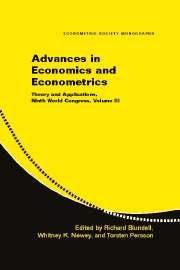Book contents
- Frontmatter
- Contents
- Contributors
- Introduction by the Editors
- 1 Identification of Nonadditive Structural Functions
- 2 Nonadditive Models with Endogenous Regressors
- 3 Heterogeneity and Microeconometrics Modeling
- 4 Heterogeneous Choice
- 5 Modeling Heterogeneity
- 6 Inference with Weak Instruments
- 7 Empirical Likelihood Methods in Econometrics: Theory and Practice
- 8 Weak Instruments and Empirical Likelihood: A Discussion of the Papers by D. W. K. Andrews, J. H. Stock, and Y. Kitamura
- 9 Estimating Continuous-Time Models with Discretely Sampled Data
- 10 Variation, Jumps, and High-Frequency Data in Financial Econometrics
- 11 Discussion of Aït-Sahalia and Barndorff-Nielsen and Shephard
- 12 Understanding Bias in Nonlinear Panel Models: Some Recent Developments
- 13 Fixed and Random Effects in Nonlinear Panel Data Model: A Discussion of a Paper by Manuel Arellano and Jinyong Hahn
- Index
- Titles in the series
4 - Heterogeneous Choice
Published online by Cambridge University Press: 05 January 2013
- Frontmatter
- Contents
- Contributors
- Introduction by the Editors
- 1 Identification of Nonadditive Structural Functions
- 2 Nonadditive Models with Endogenous Regressors
- 3 Heterogeneity and Microeconometrics Modeling
- 4 Heterogeneous Choice
- 5 Modeling Heterogeneity
- 6 Inference with Weak Instruments
- 7 Empirical Likelihood Methods in Econometrics: Theory and Practice
- 8 Weak Instruments and Empirical Likelihood: A Discussion of the Papers by D. W. K. Andrews, J. H. Stock, and Y. Kitamura
- 9 Estimating Continuous-Time Models with Discretely Sampled Data
- 10 Variation, Jumps, and High-Frequency Data in Financial Econometrics
- 11 Discussion of Aït-Sahalia and Barndorff-Nielsen and Shephard
- 12 Understanding Bias in Nonlinear Panel Models: Some Recent Developments
- 13 Fixed and Random Effects in Nonlinear Panel Data Model: A Discussion of a Paper by Manuel Arellano and Jinyong Hahn
- Index
- Titles in the series
Summary
INTRODUCTION
This paper considers nonparametric identification in models with nonadditive unobservables, where choices are either the dependent or the explanatory variables. For models where choices are dependent variables, the paper presents some of the latest developments in nonparametric identification, in the context of two popular models of consumer demand: the classical consumer demand and discrete choice. For models where choices are explanatory variables, it discusses several of the methods that have recently been developed to deal with their endogeneity.
Choice is the selection of an alternative from a set of alternatives. In many economic models, the role of economic agents is to make choices. Workers choose how to allocate their time between leisure and work-time. Consumers choose how to allocate their income between consumption and savings. Firms choose what and how much to produce. Governments choose taxes and subsidies. The usual assumption made in these economic models is that when making a choice, each economic agent has an objective function, and the choice is made so as to maximize that objective function over the set of possible alternatives.
Observable choices, made either by an agent or by different agents, are typically heterogeneous. This heterogeneity may be the result of heterogeneous choice sets, or of heterogenous objective functions. Some of this heterogeneity may be explained by different values of observable variables. Some may be explained by different values of unobservable variables. Understanding the source and shape of heterogeneity in choices is important, among other things, for accurately predicting behavior under new environments, and for evaluating the differential effect of policies over heterogeneous populations.
- Type
- Chapter
- Information
- Advances in Economics and EconometricsTheory and Applications, Ninth World Congress, pp. 75 - 110Publisher: Cambridge University PressPrint publication year: 2007
- 8
- Cited by



